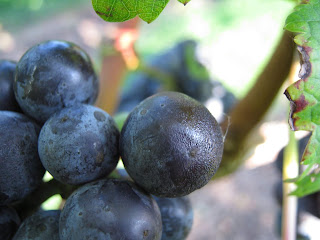This is the second part of “at bloom” fungal disease management tips. Please refer to yesterday’s post as well.
The spray timings for Botrytis is at bloom, bunch closure, and veraison. The pathogen has a wide host range and seems to be active throughout the season, but blooming time is considered as a critical timing because the pathogen can infect flowers without showing symptoms.
Please keep in your mind that Botrytis is very well known for its capacity to overcome fungicides. Thus, a rotation of mode of action groups is a very important aspect of Botrytis management. Mode of action for a particular fungicide can be found as a FRAC code, which you should be able to locate on the label. Here’s a short list of materials for Botrytis and their FRAC code in parenthesis: Elevate (17), Scala (9), Vangard (9), Switch (9+12), Inspire Super (9+3), Luna Experience (7+3)*, Kenja (7)*, Meteor/Rovral (2), Endura* (7), Pristine* (7+11), Miravis Prime (7+12)*.
The material with an asterisk has a high concern for resistance development. Please note that group 7 is considered a high-risk material. Dr. Baudoin’s lab has identified strong evidence of resistance against Endura and Pristine. For the other group 7 materials, such as Kenja, Luna, and Miravis, the way they work is the same as the other group 7 materials; however, chemical companies engineered these materials to be delivered into the pathogen differently, so that these newer materials are different in terms of how the fungicide resistance develops. Thus, it may take a while for our Botrytis isolates to find a way to overcome these materials. However, cases of fungicide resistance for these newer materials are reported in other crops or in lab studies. Thus, I would be very careful about the usage. [Also please note that Aprovia is also a group 7 material, but it does not have a label for Botrytis.]
When you are not sure how to rotate fungicides, please rotate the FRAC code because two different fungicides with two different chemical names may have the same FRAC code as you see on the list above. Also, tank-mixing with other material, such as captan, which has weak to fair activity against Botrytis, will help to lower the risk of fungicide resistance development. If you think one of the fungicides you are using is not providing sufficient control, please contact Dr. Baudoin or me.
Another management tip for Botrytis is about wounding on berries. Although Botrytis is capable of causing disease by penetrating grape’s fruit skin tissues, it prefers going after wounds. Also, at bloom infection by Botrytis tends to develop into disease when fruit skin is damaged, but when the skin is intact, the risk of disease development will be much lower, according to the study done by a Penn State group. Thus, management of the source of wounds such as insects (esp. grape berry moth), or birds, or powdery mildew at early in the season, can help to manage Botrytis. Moreover, sour rot pathogens also really like going after wounds; so, the same wound management would be the key for the sour rot management as well.
Both ripe rot and bitter rot are considered as warm season diseases, and in fact, people in the south tend to suffer more from these diseases; however, we can find ripe rot in Northern VA year after year. In addition, I have heard from growers from PA and MD that they are having issues with ripe rot as well.
Unfortunately, ripe rot, in particular, has been misdiagnosed more than other rots. It shows up as if the berries are sunburned, thus you will see round dark brown lesions on the top portion of an infected berry. The difference from sunburn is that with ripe rot, there would be the tiny dots you will see within the lesion, which are fruiting bodies of the pathogen. As time progresses, the lesion expand into the whole berry, and infected fruits become shriveled raisin-like fruits (please see the picture above). With a severe infection, you may see the majority of berries on a cluster shriveled down. Unlike sunburn, it does change the taste of the fruit and wine. Unfortunately, the change is in the negative direction, and a study showed that a consumer panel could detect only 3% contamination in the mast.
Both ripe rot and bitter rot seem to be able to infect berries from time of flowering to the harvest. Thus, protection is important, especially if you have experienced issues with these diseases in the past. Mancozeb, ziram (FRAC=M3), captan (FRAC=M4), and QoI (Strobirulin, FRAC=11) fungicides are currently recommended. But due to the 66-day PHI of mancozeb, you may not have enough days remained to spray mancozeb at this time of the season. Based on our lab and field tests, mancozeb, captan, copper (FRAC=M1), tebuconazole (FRAC=3), azoxystrobin (FRAC=11), and Swith (FRAC=9+12) provided some level of efficacy against ripe rot pathogens; however, none of the products provided sufficient degree of control by itself. Also, some of the isolates causing ripe rot are not sensitive to some of those materials. Thus, when it comes to ripe rot managenent, please think of not only a rotaion of modes of action, but also a tank mix of at least two modes of action. The timing of the application will be similar to that of Botrytis: bloom, bunch closure, and veraison.


